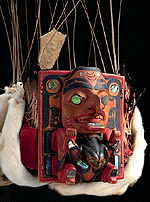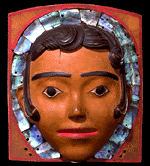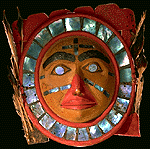
Frontlets
 |
This portrayal of the mythic Dogfish Woman is one of the finest examples of Haida frontlets from Skidegate village. It has a train of ermineskin, flicker feathers at the sides, and sea lion whiskers at the top; the eyes and joints are inset with abalone. Collected ca. 1898 by Charles F. Newcombe. CMC VII-B-1102 Chiefs of all the tribes of the Pacific north coast possessed an array of regalia which denoted status. The full set of chiefly regalia consisted of a Chilkat blanket, leggings, an apron, Raven rattles (or a drum), and a frontlet. A chief was also likely to own a shield-shaped plate of native copper. All the north coast groups adopted the frontlet, but they each developed distinctive styles. The typical Tsimshian frontlet is a human figure with a head larger than its body and limbs, squeezed into a rectangular or dome-topped plaque that is surrounded by small human or crest animal figures. The frontlet of the Nisga'a of the Nass River has shallow rounded carving of the central human figure, with squares of abalone shell surrounding it. |
 |
Haida frontlet depicting a young woman, carved by Simeon Stiltla, collected at Masset before 1884 by Dr. William F. Tolmie. CMC VII-B-25 The Tlingit frontlet has a more irregular pattern of small figures around the central figure, which is usually a crest animal rather than a human; the colours are more variable than the standard black and red used by the Haida, with a preference for green and grey. The Haida frontlet is mid-way between those of the Tsimshian and Tlingit, in that animal figures are common in the centre but human figures are not rare. The Haida carve the central figure in higher relief and outline its eyes with a black line. Haida frontlet plaques are as often round or oval as they are rectangular. |
 |
This Haida frontlet represents the Moon. The abalone inlays on the face and rim of the Moon reflected firelight, while the flicker feathers served as an invocation to that bird to carry the chief's prayer's skyward. Probably acquired at Skidegate before 1899 by James Deans for the A. Aaronson collection. CMC VII-B-690 The north coast frontlet embodies a complex cosmological message in which the dominate reference, conveyed both by the visual forms and by the materials used, relates to beings of the sea and the underworld. However, images of humans representing the middle world, and birds the upper world, are not excluded. The sea world and underworld references include the painted leather Whale tail that projects from the back and the sea lion whiskers on top that form the cage into which eagle down is placed. The flicker feathers that adorn the sides of the headpiece represent the role of messenger played by those birds, which are said to travel up and down the world tree. Similarly, the ermineskin train refers to the role that creature plays in marking the seasons through its changes of colour. The abalone shell, which comes from the sea, is thought to reflect the sky world. |
